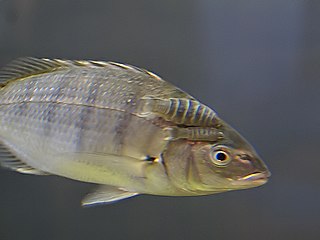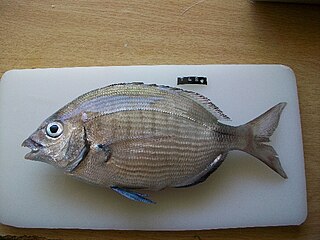
Hake is the common name for fish in the Merlucciidae family of the northern and southern oceans and the Phycidae family of the northern oceans. Hake is a commercially important fish in the same taxonomic order, Gadiformes, as cod and haddock.

Sciaenidae is a family of ray-finned fishes belonging to the order Acanthuriformes. They are commonly called drums or croakers in reference to the repetitive throbbing or drumming sounds they make. The family consists of about 293 to 298 species in about 66 or 67 genera.

The Zeidae are a family of large, showy, deep-bodied zeiform marine fish—the "true dories". Found in the Atlantic, Indian, and Pacific Oceans, the family contains just six species in two genera. All species are important and highly regarded food fish supporting commercial fisheries, and some—such as the John Dory —are enjoyed in large public aquaria. These fish are caught primarily by deep-sea trawling.

Emmelichthys nitidus, the Cape bonnetmouth, bonnetmouth, redbait, pearl fish, picarel, red baitfish, red herring or Southern rover, is a species of marine ray-finned fish belonging to the family Emmelichthyidae, the rovers and bonnetmouths. This species is found in the Indian and Pacific oceans. This species is of minor importance to commercial fisheries.

Argyrosomus regius, also known as the meagre, croaker, jewfish, shade-fish, sowa, kir, corvina, salmon-bass or stone bass, is a species of fish of the family Sciaenidae. This large fish has a pearly-silver to brownish coloration and a yellow-coloured mouth. It is native to the eastern Atlantic Ocean, as well as the Mediterranean and Black Seas.

Argyrosomus is a genus of marine ray-finned fishes belonging to the family Sciaenidae, the drums. The fish in this genus are large and are commonly targeted as game fish.

Argyrosomus japonicus is a silvery to bronze-green colored fish, a member of the family Sciaenidae, which may grow up to 2 m in length. It is known as Japanese meagre (FAO), mulloway or jewfish in the eastern states of Australia, mulloway in South Australia, kingfish or river kingfish in Western Australia, and dusky kob, dusky salmon, salmon, Kob, or kabeljou in South Africa, Ô-nibe in Japan, Sawwa Krokar Fish or Sawwa Machli in Pakistan. The name jewfish refers to its large otoliths, which are prized as "jewels" by some fishers.

Chrysoblephus gibbiceps, the red stumpnose, red stumpnose seabream or Miss Lucy, is a species of marine ray-finned fish belonging to the family Sparidae, the seabreams and porgies. This fish is endemic to the southwestern Indian Ocean off the coast of South Africa. The International Union for Conservation of Nature classifies this species as Endangered.

Cynoscion arenarius, sand seatrout, sand weakfish or white trout, is a species of marine ray-finned fish belonging to the family Sciaenidae, the drums and croakers. It is found in the western Atlantic Ocean. It is closely related to the common weakfish and may be a subspecies of C. regalis.

The brown meagre or corb is a species of marine ray-finned fish belonging to the family Sciaenidae, the drums and croakers. This species found in, the eastern Atlantic, Mediterranean Sea and Black Sea occurring in shallow waters and sandy bottoms. It is harvested for human consumption, especially in the Mediterranean.

Otolithes ruber, commonly known as the tigertooth croaker, silver teraglin, wiretooth, snapper kob, snapper salmon, Yankee whiting or Yankee salmon is a species of marine ray-finned fish belonging to the family Sciaenidae, the drums and croakers. This species is found in the Indo-Pacific region.

Reeve's croaker, also known as the goldbelly croaker, golden corvina, yellowfin croaker or yellowfin corvina, is a species of marine ray-finned fish belonging to the family Sciaenidae, the drums and croakers. This species is found in the coastal waters of the Indo-Pacific region. It is the only species in the monospecific genus Chrysochir.

The west coast seabream or west coast steenbras is a species of marine fish in the family Sparidae. It is found in very shallow water off the coasts of to Angola, Namibia and South Africa. The International Union for Conservation of Nature lists its conservation status as being "near threatened".

Umbrina canariensis, the Canary drum is a warm water, marine fish of the family Sciaenidae which is found in the western Mediterranean, eastern Atlantic Ocean and western Indian Ocean. Other English vernacular names are tesselfish, baardman, checker drum, common baardman, tasselfish and bellman.

Argyrozona is a monospecific genus of marine ray-finned fish belonging to the family Sparidae, the seabreams and progies. Its only species is Argyrozona argyrozona, the carpenter seabream or doppie, which is endemic to the waters off southern South Africa.

Diplodus capensis, the Cape white seabream or blacktail seabream, is a species of marine ray-finned fish belonging to the family Sparidae, which includes the seabreams and porgies. This fish is found around the coasts of Southern Africa.

Argyrosomus hololepidotus, also known as the Madagascar meagre or southern meagre, is a species of marine ray-finned fish belonging to the family Sciaenidae, the drums and croakers. The species is endemic to Madagascar and the Indian Ocean.

The geelbeck croaker, also known as the African weakfish or Cape salmon, is a species of marine ray-finned fish belonging to the family Sciaenidae, the drums and croakers. This species is found in the southwestern Indian Ocean off southeastern Africa.

The half-mourning croaker is a species of marine ray-finned fish belonging to the family Sciaenidae, the drums and croakers. It is the only species in the monospecific genus Paranibea. This fish is found in the Indo-Pacific region.
Argyrosomus coronus, also known as the westcoast dusty kob, is a species of marine ray-finned fish belonging to the family Sciaenidae, the drums and croakers.




















